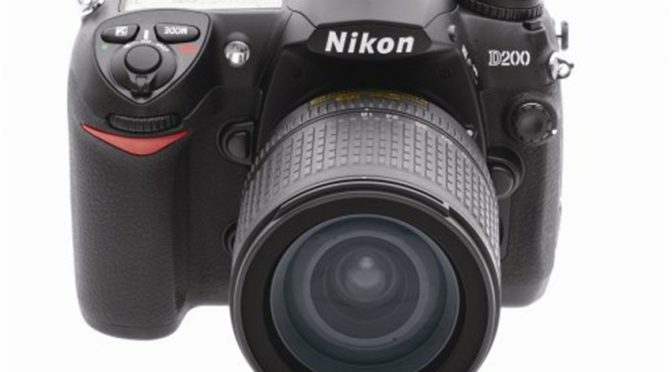The Nikon D200, originally introduced in November 2005 as a successor to the Nikon D100, is a midrange digital SLR camera that comes with a rugged body, plentiful controls and accessories, excellent image quality, compact design, superior build quality and strong performance. It represented a major upgrade over the D100 and shares far more with the Nikon D2X, the latest in Nikon’s series of DSLR’s, in terms of performance than its earlier version. It’s clear it was launched to compete with Canon EOS 5D.
Product Description
The D200 features a new design that seems like a hybrid of the Nikon D50/D70 and D2 series. The camera’s body construction, including the lightweight magnesium metal framing, is similar to that of a D2X camera. Its pop-up flash, battery and size are more like those of the D100/70/50 progression, but its feature set, menus and button layout mimic those of a D2X.
The body feels light and looks right. The markings are clear and lines clean, giving the camera a smoother feel compared to the D1 series. Many of the camera’s controls and buttons are identical to those of the D2X, but the camera’s overall handling is easy and efficient.
The Nikon D200 uses a 10.2 million pixel CCD sensor made by Sony, allowing for production of top quality 3872 x 2592 pixel images – enough to create straight-from-camera prints up to 11×16″ without the need for resizing.
The battery performance is good, but it largely depends on how the camera is used. It produces a superb performance when shooting JPEG only. In fact, the camera can handle 800 (JPEG) shots per charge. But when it comes to shooting NEF or NEF+JPEG, it can be disappointing.
The performance of Compact-Flash write is excellent, but it’s still below that of D2X. With the correct card, the D200 can easily achieve 8MBs write speed.
The autofocus performance is also great. It’s better than that of the D70, but worse than that of the D2X. Like the D100, the D200 works best in low light conditions when the central AF sensor is the active sensor. The camera’s outlaying sensors are also good.
With an excellent color consistency across the ISO values (96% at ISO 1600, 99% at ISO 100, for example), the Nikon D200 color integrity is simply wonderful. But the saturation may be slightly lower for Adobe RGB images. While its resolution is far below the D2X level, the D200 produces respectable landscape shots, with enough details. It packs plenty of pixels, and acquires and produces them very well.
Features

– Magnesium alloy body
– 10. 2mp CCD sensor
– Optical Low Pass Filter
– High speed 4-channel data output
– New 11-area AF system
– Built-in Speedlight with flash control
– New high-performance EN-EL3e rechargeable lithium ion battery
– Large, bright viewfinder
– 2.5 LCD with ultra-wide 170 degree viewing angle
– GPS support
– “30“ 1/8,000 sec. shutter speeds
– 5 fps in bursts of up to 22 NEF images or 37 JPEG images
– Image optimization modes
– 3D Color Matrix Metering II
– Full support for Nikon creative lighting system
– Nikon’s PictureProject software
Pros:
– Comes with many superb customization features and options
– Has a robust build quality and set of features
– It’s affordable (probably the cheapest “semi professional” camera available)
Cons:
– It uses old technology and the sensors are somewhat noisy
– The camera has no auto modes
Conclusion
The Nikon D200 offers great value for money. It’s perfect for advanced users who need a good photographer’s camera with many customization features but are working with a tight budget.
